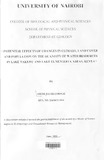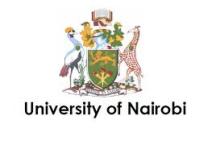Resource information
This study evaluates the potential effects of changes in climate, population and land cover on the
quantity of surface water and groundwater resources in Lake Nakuru and Lake Elmenteita areas.
Multiple linear regression analysis of the variables was done using Statistical Package for Social
Sciences (SPSS) to achieve this objective. Population grows in the area at the rate of 3.4% to
4.5% while natural vegetation cover is diminishing at 2.5% annually. There is constant rise in
daily minimum temperature while there is a rise in the mean annual precipitation. The area’s
domestic water demand per capita is projected to rise from 50 litres per day in 1971 to 160 litres
per day in 2030. This, based on the rate of population growth, will translate to a soaring total
demand of 174,000,000 m3 annually by the year 2030.
Strong positive correlation between precipitation and discharge is observed, indicating that
rainfall is the main source of surface water in the area. The precipitation is thus expected to
influence the occurrence of extreme events, with droughts projected for the year 2001, 2012,
2016, 2021 and 2028 while floods are projected to occur in 2006, 2009, 2018, 2024 and 2030.
To mitigate against the deteriorating surface and groundwater resources in the area, there is need
to restore Mau escarpment since it is the most affected. Resettlement of the inhabitants will be
key to ensuring sustainable water supply. The reforestation of Mau catchment should take into
account promoting cross-breeding to produce superior tree species. These species should be fastmaturing,
heat-and-drought tolerant and pest-and-disease-resistant.
Measures that are recommended to reduce green house gas emissions and vegetation loss
include slowing deforestation, enhancing natural forest generation, establishing tree plantation,
promoting agroforestry and altering management of agricultural soils and rangelands. Enhanced
resilience to future periods of drought stress can be supported by improvements in present rainfed
farming systems, such as water harvesting systems to supplement irrigation practices in dry
areas. Improved early warning systems and their application may also reduce vulnerability to
future risks associated with climate variability and change. Increased investment in dams will
improve harvesting of water that would cause flooding during heavy rains. This would later be
used to mitigate against the effects of droughts.


